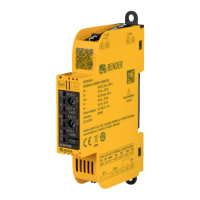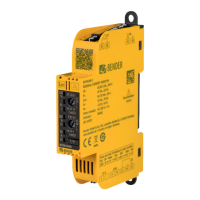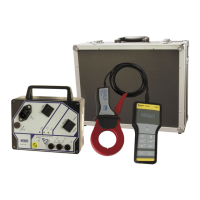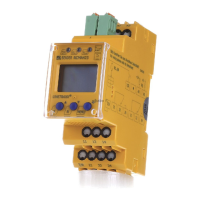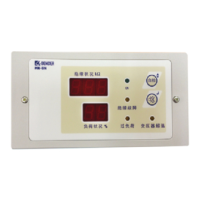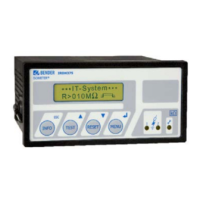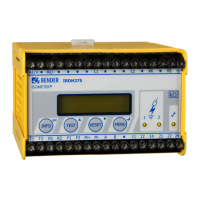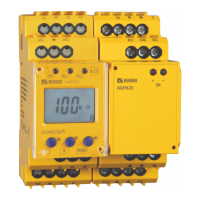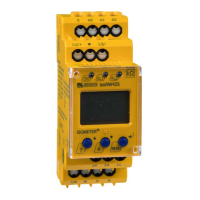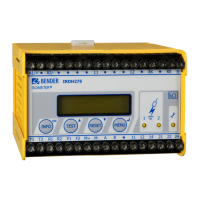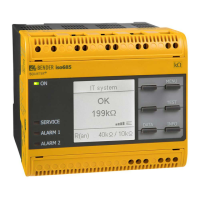Do you have a question about the Bender LINETRAXX RCM420 and is the answer not in the manual?
Guidance on effectively using the manual for product understanding.
Explains the meaning of danger, warning, caution, and advice symbols used in the manual.
Illustrates and defines symbols used to convey important information about the device and its handling.
Provides contact information and website for customer service, repair, and field service for Bender devices.
Information on available training courses and seminars for customers and interested parties.
Outlines the applicable sales and delivery conditions set by Bender GmbH & Co. KG.
Guidelines for checking packaging, handling transport damage, and proper storage of devices.
Details conditions under which warranty and liability claims are excluded for personal injury and property damage.
Advises adherence to national regulations and laws governing the disposal of Bender devices.
Outlines safety precautions, particularly regarding the risk of fatal injury due to electric shock.
Describes the AC and pulsed DC sensitive residual current monitor's designed application in earthed power supply systems.
Lists the key technical features and capabilities of the RCM420 residual current monitor.
Explains the operational principles, including measurement, response delays, and alarm signaling.
Details how the device monitors CT connections and reports faults with error codes.
Covers automatic/manual self-tests, functional faults, and their display indications.
Explains setting reload cycles and assigning alarm categories to output relays.
Details the function and setting of various time delays affecting alarm signaling.
Explains monitoring residual current within defined upper and lower thresholds.
Describes password protection activation and restoring device to factory defaults.
Covers history memory function and the use of the external test/reset button.
Details fault memory configuration options and behavior during power loss.
Explains connecting and configuring a second external current transformer for higher currents.
Instructions for securely mounting the device onto a standard DIN rail.
Instructions for fixing the device using screws and mounting clips.
Provides instructions to connect the device according to the wiring diagram.
Presents the detailed wiring diagram for connecting the RCM420 to power and external components.
Detailed explanation and diagram for connecting a second current transformer to extend the measurement range.
Steps to follow for the proper commissioning of the residual current monitor after installation.
Details the function of each element displayed on the device's screen and indicators.
Explains the purpose and function of each physical button and LED on the device's front panel.
Provides an overview of the device's menu system, detailing parameters and their adjustable options.
Describes how the device displays measured values and response values in its default operating mode.
Explains how to navigate and interpret display information within the device's menu structure.
Explains how to set the main alarm (IΔn2) and prewarning (IΔn1) response values for overcurrent.
Details how to configure the hysteresis percentage for prewarning and main alarm response values.
Explains how to configure the fault memory (activate, deactivate, continuous mode).
Demonstrates setting alarm relay K1 to Normally Open (N/O) operation.
Explains how to assign different alarm categories to alarm relays.
Shows how to deactivate the device error alarm category for alarm relay K1.
Demonstrates deactivating the response value I1 (prewarning) alarm category for relay K1.
Illustrates activating the response value I2 (main alarm) category for alarm relay K1.
Shows how to deactivate the 'Alarm by device test' category for alarm relay K1.
Explains how to set response delay, starting delay, and delay on release.
Step-by-step guide on how to set the response delay for alarm relay K1.
Step-by-step guide on how to set the starting delay for the device.
Describes switching between operating modes like overcurrent, undercurrent, and window.
Explains how to set the correction factor for an additional cascaded current transformer.
Details how to activate, change, or deactivate password protection for device settings.
Step-by-step instructions for changing the existing password for device access.
Instructions on how to disable the password protection feature on the device.
Instructions for restoring the device to its original factory settings.
Explains how to query software version and other device information.
Describes how to view and clear the history memory containing previous alarm values.
Lists the default factory settings for various parameters of the RCM420.
Provides a list of common error codes, their meanings, and recommended actions.
Presents technical specifications and data in a tabular format for easy reference.
Specifies insulation coordination data according to relevant IEC standards.
Details the supply voltage ranges and operating ranges for the device.
Provides technical specifications related to the measuring circuit and current transformers.
Lists the rated residual operating currents for prewarning (AL1) and main alarm (AL2).
Details the specified time parameters, including starting delay, response delays, and delay on release.
Lists specifications related to the display, error indication, and memory functions.
Provides specifications for device inputs and outputs, such as cable length for external buttons.
Specifies maximum cable lengths for measuring current transformers based on wire type.
Details the specifications of the switching elements, including operating principle and service life.
Lists environmental conditions and EMC compliance standards for the device.
Highlights specific data points that differ for the 'W' option compared to the standard version.
Provides connection details for UL applications and specifications for terminal types.
Lists miscellaneous technical specifications such as operating mode, enclosure material, and software version.
Lists the standards, approvals, and certifications the device complies with.
Provides information on how to order the device and related accessories, including part numbers.
Lists available external measuring current transformers with their specifications and part numbers.
Details the history of revisions made to the document, including dates and changes.
Guidance on effectively using the manual for product understanding.
Explains the meaning of danger, warning, caution, and advice symbols used in the manual.
Illustrates and defines symbols used to convey important information about the device and its handling.
Provides contact information and website for customer service, repair, and field service for Bender devices.
Information on available training courses and seminars for customers and interested parties.
Outlines the applicable sales and delivery conditions set by Bender GmbH & Co. KG.
Guidelines for checking packaging, handling transport damage, and proper storage of devices.
Details conditions under which warranty and liability claims are excluded for personal injury and property damage.
Advises adherence to national regulations and laws governing the disposal of Bender devices.
Outlines safety precautions, particularly regarding the risk of fatal injury due to electric shock.
Describes the AC and pulsed DC sensitive residual current monitor's designed application in earthed power supply systems.
Lists the key technical features and capabilities of the RCM420 residual current monitor.
Explains the operational principles, including measurement, response delays, and alarm signaling.
Details how the device monitors CT connections and reports faults with error codes.
Covers automatic/manual self-tests, functional faults, and their display indications.
Explains setting reload cycles and assigning alarm categories to output relays.
Details the function and setting of various time delays affecting alarm signaling.
Explains monitoring residual current within defined upper and lower thresholds.
Describes password protection activation and restoring device to factory defaults.
Covers history memory function and the use of the external test/reset button.
Details fault memory configuration options and behavior during power loss.
Explains connecting and configuring a second external current transformer for higher currents.
Instructions for securely mounting the device onto a standard DIN rail.
Instructions for fixing the device using screws and mounting clips.
Provides instructions to connect the device according to the wiring diagram.
Presents the detailed wiring diagram for connecting the RCM420 to power and external components.
Detailed explanation and diagram for connecting a second current transformer to extend the measurement range.
Steps to follow for the proper commissioning of the residual current monitor after installation.
Details the function of each element displayed on the device's screen and indicators.
Explains the purpose and function of each physical button and LED on the device's front panel.
Provides an overview of the device's menu system, detailing parameters and their adjustable options.
Describes how the device displays measured values and response values in its default operating mode.
Explains how to navigate and interpret display information within the device's menu structure.
Explains how to set the main alarm (IΔn2) and prewarning (IΔn1) response values for overcurrent.
Details how to configure the hysteresis percentage for prewarning and main alarm response values.
Explains how to configure the fault memory (activate, deactivate, continuous mode).
Demonstrates setting alarm relay K1 to Normally Open (N/O) operation.
Explains how to assign different alarm categories to alarm relays.
Shows how to deactivate the device error alarm category for alarm relay K1.
Demonstrates deactivating the response value I1 (prewarning) alarm category for relay K1.
Illustrates activating the response value I2 (main alarm) category for alarm relay K1.
Shows how to deactivate the 'Alarm by device test' category for alarm relay K1.
Explains how to set response delay, starting delay, and delay on release.
Step-by-step guide on how to set the response delay for alarm relay K1.
Step-by-step guide on how to set the starting delay for the device.
Describes switching between operating modes like overcurrent, undercurrent, and window.
Explains how to set the correction factor for an additional cascaded current transformer.
Details how to activate, change, or deactivate password protection for device settings.
Step-by-step instructions for changing the existing password for device access.
Instructions on how to disable the password protection feature on the device.
Instructions for restoring the device to its original factory settings.
Explains how to query software version and other device information.
Describes how to view and clear the history memory containing previous alarm values.
Lists the default factory settings for various parameters of the RCM420.
Provides a list of common error codes, their meanings, and recommended actions.
Presents technical specifications and data in a tabular format for easy reference.
Specifies insulation coordination data according to relevant IEC standards.
Details the supply voltage ranges and operating ranges for the device.
Provides technical specifications related to the measuring circuit and current transformers.
Lists the rated residual operating currents for prewarning (AL1) and main alarm (AL2).
Details the specified time parameters, including starting delay, response delays, and delay on release.
Lists specifications related to the display, error indication, and memory functions.
Provides specifications for device inputs and outputs, such as cable length for external buttons.
Specifies maximum cable lengths for measuring current transformers based on wire type.
Details the specifications of the switching elements, including operating principle and service life.
Lists environmental conditions and EMC compliance standards for the device.
Highlights specific data points that differ for the 'W' option compared to the standard version.
Provides connection details for UL applications and specifications for terminal types.
Lists miscellaneous technical specifications such as operating mode, enclosure material, and software version.
Lists the standards, approvals, and certifications the device complies with.
Provides information on how to order the device and related accessories, including part numbers.
Lists available external measuring current transformers with their specifications and part numbers.
Details the history of revisions made to the document, including dates and changes.
| Brand | Bender |
|---|---|
| Model | LINETRAXX RCM420 |
| Category | Measuring Instruments |
| Language | English |
